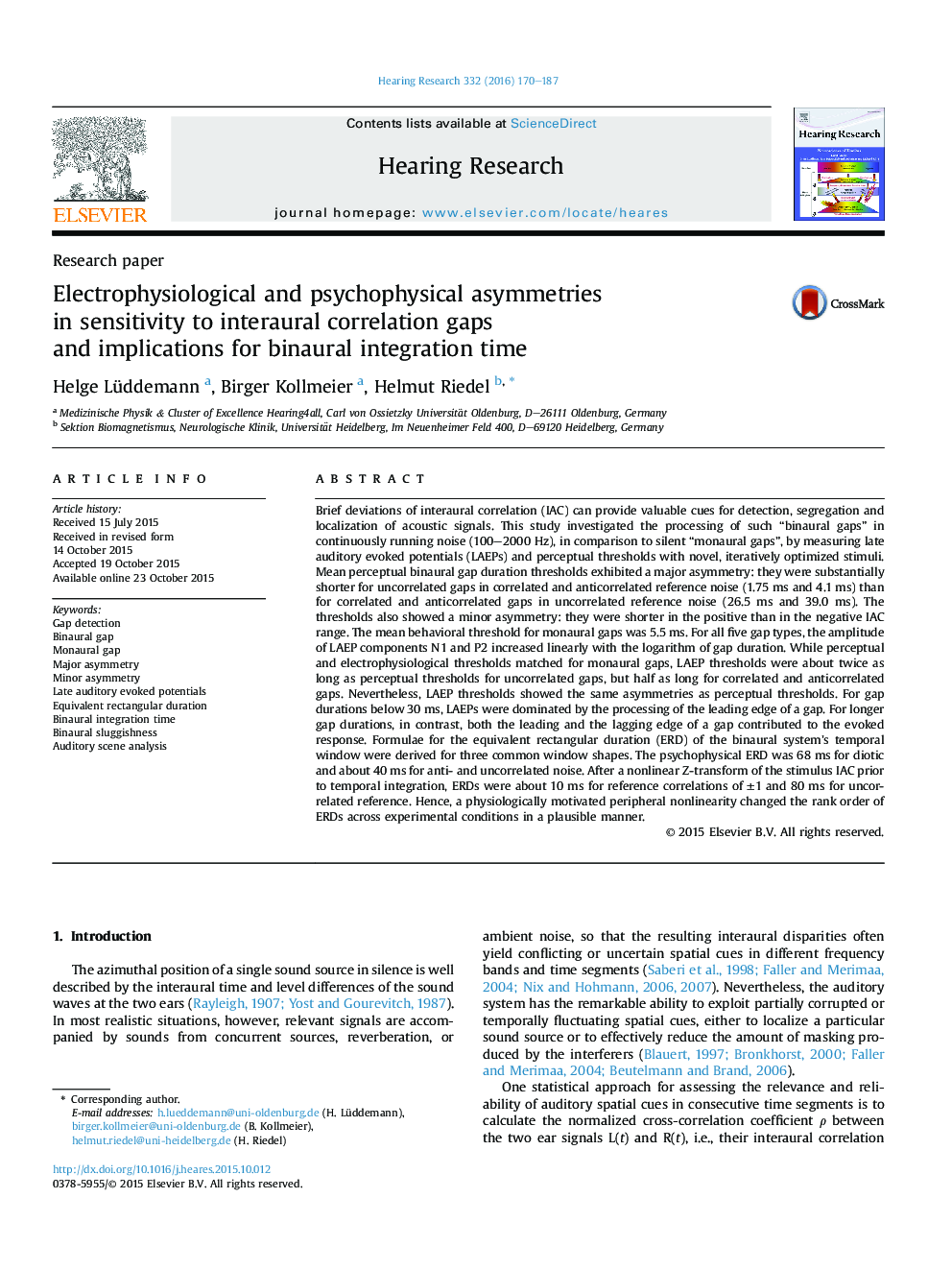| کد مقاله | کد نشریه | سال انتشار | مقاله انگلیسی | نسخه تمام متن |
|---|---|---|---|---|
| 6287156 | 1615568 | 2016 | 18 صفحه PDF | دانلود رایگان |
عنوان انگلیسی مقاله ISI
Electrophysiological and psychophysical asymmetries in sensitivity to interaural correlation gaps and implications for binaural integration time
ترجمه فارسی عنوان
عدم تقارن الکتروفیزیولوژیکی و روانشناختی در حساسیت به شکاف همبستگی بین فضایی و پیامدهای آن برای یکپارچگی دو طرفه
دانلود مقاله + سفارش ترجمه
دانلود مقاله ISI انگلیسی
رایگان برای ایرانیان
کلمات کلیدی
تشخیص فاصله، شکاف دو طرفه، شکاف مونورال، عدم تقارن عمده، عدم تقارن جزئی، شنوایی دیررس بالقوه است، مدت زمان مستطیلی معادل، یکپارچه سازی دو زمانه، تنش دو طرفه، تجزیه و تحلیل صحنه های شنیداری،
موضوعات مرتبط
علوم زیستی و بیوفناوری
علم عصب شناسی
سیستم های حسی
چکیده انگلیسی
Brief deviations of interaural correlation (IAC) can provide valuable cues for detection, segregation and localization of acoustic signals. This study investigated the processing of such “binaural gaps” in continuously running noise (100-2000 Hz), in comparison to silent “monaural gaps”, by measuring late auditory evoked potentials (LAEPs) and perceptual thresholds with novel, iteratively optimized stimuli. Mean perceptual binaural gap duration thresholds exhibited a major asymmetry: they were substantially shorter for uncorrelated gaps in correlated and anticorrelated reference noise (1.75 ms and 4.1 ms) than for correlated and anticorrelated gaps in uncorrelated reference noise (26.5 ms and 39.0 ms). The thresholds also showed a minor asymmetry: they were shorter in the positive than in the negative IAC range. The mean behavioral threshold for monaural gaps was 5.5 ms. For all five gap types, the amplitude of LAEP components N1 and P2 increased linearly with the logarithm of gap duration. While perceptual and electrophysiological thresholds matched for monaural gaps, LAEP thresholds were about twice as long as perceptual thresholds for uncorrelated gaps, but half as long for correlated and anticorrelated gaps. Nevertheless, LAEP thresholds showed the same asymmetries as perceptual thresholds. For gap durations below 30 ms, LAEPs were dominated by the processing of the leading edge of a gap. For longer gap durations, in contrast, both the leading and the lagging edge of a gap contributed to the evoked response. Formulae for the equivalent rectangular duration (ERD) of the binaural system's temporal window were derived for three common window shapes. The psychophysical ERD was 68 ms for diotic and about 40 ms for anti- and uncorrelated noise. After a nonlinear Z-transform of the stimulus IAC prior to temporal integration, ERDs were about 10 ms for reference correlations of ±1 and 80 ms for uncorrelated reference. Hence, a physiologically motivated peripheral nonlinearity changed the rank order of ERDs across experimental conditions in a plausible manner.
ناشر
Database: Elsevier - ScienceDirect (ساینس دایرکت)
Journal: Hearing Research - Volume 332, February 2016, Pages 170-187
Journal: Hearing Research - Volume 332, February 2016, Pages 170-187
نویسندگان
Helge Lüddemann, Birger Kollmeier, Helmut Riedel,
